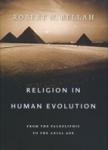Ritual and Myth
During his long and distinguished academic career, Robert Bellah, emeritus professor of sociology at Berkeley, introduced concepts that have shaped the way in which we think of the roles of religion in modern society. His analyses of American civil religion in Varieties of Civil Religion (1970) and The Broken Covenant (1975) and of cultural shifts in social cohesion Habits of the Heart (1985) have become familiar classics. In addition, Bellah has contributed important studies detailing the complex religious landscape of pre-industrial Japan in Tokugawa Religion (1957) and modern times, Imagining Japan (2003). This new volume, some 13 years in the writing, departs from sociological analysis of modern or well-documented societies to engage questions concerning religious activities and perceptions from the origins of human societies to a watershed period in the second half of the first millennium B.C.E.
Given the broad sweep of human history and culture that Bellah explores, he cannot embrace a single definition of “religion” that might be traced from one example to the next. He embraces multiple insights into the social functioning of religious symbolism from classical sociology of religion, contemporary anthropology, psychology of religion, child psychology and even theories of play among primates and humans. Three distinctive stages in psychological development recur in various guises throughout the book: (a) bodily acting out of religious meaning (mimesis); (b) symbolic use of visual icons and narratives (myth) and (c) cognitive, conceptual analysis (theory). The primacy of mimetic actions associates ritual behavior in primate and pre-linguistic human societies. Anthropological studies of ritual in primitive tribes from the central Brazilian Kalapalo and the Walbiri aborigines in Australia to the Navajo in the American Southwest demonstrate the stability of ritual as well as its social necessity.
The first major social reconfiguration saw humans shifting from small tribal groups, in which there were minimal distinctions of power and status, to states ruled by powerful kings, which incorporate distinctions between nobility and commoners. Bellah begins with Polynesia (Hawaii) before shifting to the emergence of empires in the Near East (Mesopotamia and Egypt) and China (Shang and western Zhou). The latter set up the case for Bellah’s primary focus, the axial age transitions represented by religious developments in ancient Israel, Greece, China and India. Bellah refers to these societies that have managed to unite tribes or small city states in larger territorial units as archaic.
Treatments of the axial age in Israel, Greece, China and India occupy over half of the book. The term axial, adopted from philosophers like Karl Jaspers rather than social scientists or historians, assumes that a critical “break” or transition in human consciousness occurred at approximately the same time in these diverse societies. Though Bellah insists that attending to the social and historical particulars in each of the four examples avoids the pitfalls of metatheory, he employs a set of criteria to distinguish axial breakthroughs from comparable developments. The critical distance from the political and cultural world that such insights foster takes a variety of forms. Bellah’s construction of the development of Israel’s religion highlights the covenant theology of the Deuteronomic authors of the fifth century B.C.E. The older royal ideology is subordinated to the requirement that all Israelites are united in God’s covenant love and are obedient to the Torah. The Jewish expressions of the theoretic breakthrough may lack the elements of abstract, scientific reflection on the nature of things one finds in other examples, but it comes closest to a realized utopia.
When Bellah shifts to ancient Greece—or more appropriately for the axial breakthrough one should say ancient Athens—his categories become more puzzling. Somewhat dated accounts of religious practices, civic sacrifices and Dionysus mysteries are mentioned. But the cultural story is carried by tragedians and philosophers. A forced march through the pre-Socratics and Sophists brings readers to Socrates and Plato, whose artistry unites the worlds of literary art (drama) and philosophy. As revolutionary as the political project in Plato’s Republic is, the cultural audacity of claiming to unseat the Homeric hegemony is even greater. The social carrier for this breakthrough is the school, not the city-state.
The examples of China and India prove equally complex and will be more difficult to follow for readers unfamiliar with the history and culture of those countries. Bellah provides longer quotations from the writings to which he refers as an aid to readers who cannot pull Confucian, Daoist, Buddhist and other texts off the shelf. To preserve the chronological case for the axial age in India, Bellah must reject the possibility that the Upanishads (philosophic texts) count. Despite a theoretic turn in thought, society remains archaic. Buddhism provides the theoretic breakthrough of a cosmic law taught to all, coupled with a social alternative in the Sangha.
Professor Bellah has digested massive amounts of scholarly literature on every topic that he discusses. Consequently, the reader has the feeling of sitting through a series of graduate seminars. One might best see this work as an attempt to do for the 21st century what the great sociologist of religion Max Weber did for the 20th in treating Judaism, China and India. Its success will be measured by the extent to which this volume finds its way into the academic discussion.
This article also appeared in print, under the headline “Ritual and Myth,” in the October 17, 2011, issue.








